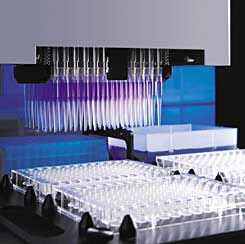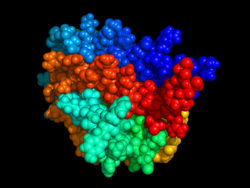4. Lead Generation
Step 4. Lead Generation
This step consists in finding a molecule that will interact with the target. The molecule might come from a natural source, e.g., a plant, or might have been made by chemists. These are called ‘small molecules’. Hundreds of thousands of molecules will be tested to find ‘leads’ – ones that interact with the target. Testing for leads is called a screening process. Modern robotic technology allows for ‘high throughput’ screening. This means that millions of molecules can be tested quickly. Once the leads have been generated or found, the process can move to the next step.

Figure 3. Robotic high throughput screening
It is also possible to find large molecules (proteins) which interact with the target. These large molecules are much more complicated to make. They are produced by biotechnology processes and are therefore described as ‘biologics’. In biotechnology, the large molecules are produced by host cells of a living organism such as bacteria, yeasts, or animal cells in large fermentation vats. The proteins are then separated and purified. The purified proteins can then be used to explore interactions with the target.

Figure 4.
Representation of erythropoietin, a very large protein.
Erythropoietin is a naturally occurring protein, but it has been used as a biologic therapy in patients whose bodies cannot produce a sufficient amount of it. The cells in the fermentation vats have been genetically engineered so that they produce large amounts of erythropoietin.
Traditionally, the pharmaceutical industry produced ‘small molecules’ which were then developed as new medicines. Currently also large molecules (proteins) or ‘biologics’ are produced. Both small molecules and biologics are important in medicines development.